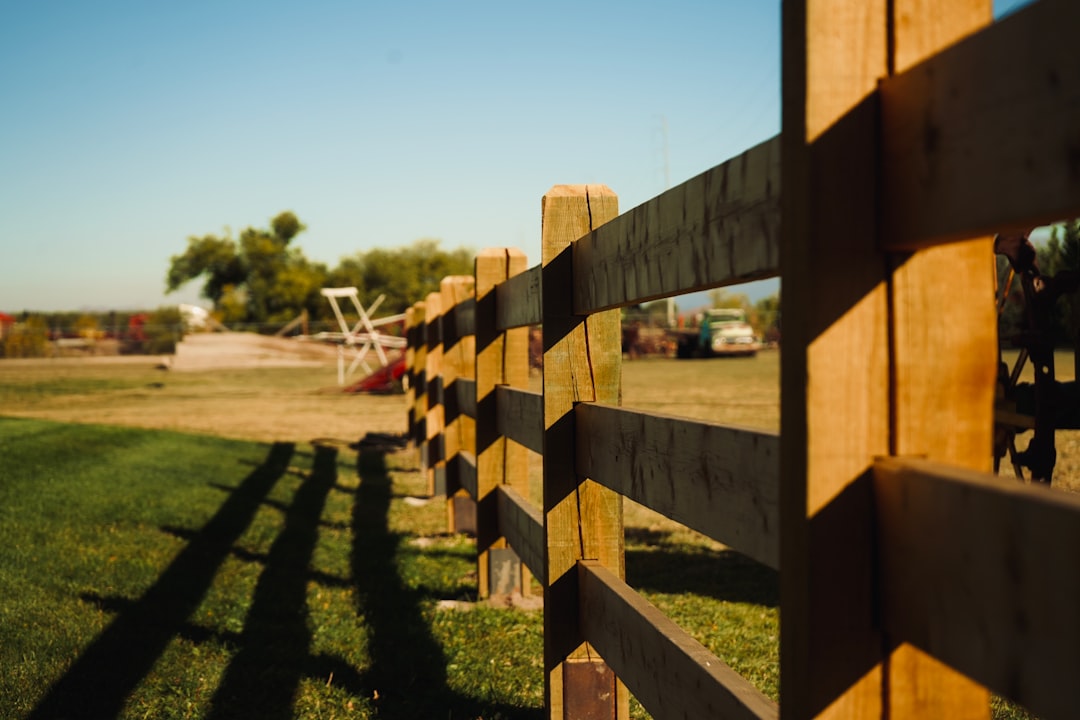

Engage prospects with a scan and streamline customer engagement with FREE QR code marketing tools by Sona – no strings attached!
Create a Free QR CodeFree consultation

No commitment

Engage prospects with a scan and streamline customer engagement with FREE QR code marketing tools by Sona – no strings attached!
Create a Free QR CodeFree consultation

No commitment

QR codes bridge the gap between real-world engagement and digital action in fencing contracting, whether on yard signs, flyers, job site banners, or fleet vehicles. Many contractors face the persistent frustration of prospects engaging with their brand in person but failing to convert because there is no easy way to track those touchpoints or prompt the next step. QR codes solve this by turning every physical impression into a measurable, interactive moment that routes prospects to the exact action you want them to take.
Replacing analog processes with QR-triggered workflows reduces friction for homeowners and gives teams complete visibility into which materials, messages, and placements drive the highest-value opportunities. Instead of relying on business cards, printed brochures, and phone number tear tabs, a scan can open a mobile quote form, a gallery organized by fence type, or a scheduler that books a site visit in seconds. Platforms like Sona QR make it simple to create dynamic codes and sync every scan into a CRM for real-time follow-up and attribution.
Integrated QR solutions like Sona QR offer dynamic code creation, editable destinations, and full-funnel performance tracking stitched to Sona.com for attribution. For broader measurement clarity across offline channels, see Sona on offline attribution. This lets fencing contractors nurture every high-value prospect with far less manual effort, fewer data gaps, and a clear view from scan to sold project.

Fencing contractors operate in an industry where physical demonstration meets high-touch sales and where digital expectations continue to rise. Prospects often encounter your brand in the wild: they drive past job sites, pick up brochures at a trade show, or notice a neighbor’s new fence. Without a direct digital onramp at that moment, their interest can fade, and the lead disappears. QR codes give that passerby a reason to act now and make it easy to do so with a single scan, no app required.
Another recurring challenge is the visibility gap. Yard signs and printed flyers may spark interest, but you rarely know which ones are working or what content resonates. QR scans create a data trail that shows which neighborhoods engage most, which materials attract attention, and which offers drive estimate requests. Dynamic codes let you evolve your offers as seasons change and align creative with what your analytics reveal.
As a practical example, assign unique QR codes to direct mail by neighborhood. You will learn which areas generate the most estimate requests, then build segmented retargeting audiences for follow-up campaigns that highlight the materials and price points that matched local interest. For location-aware campaigns, explore geo-fencing QR codes.
In fencing, missed conversions often stem from generic or inconvenient calls to action. A homeowner may admire your installation across the street yet ignore the phone number on the sign because they are in a hurry. The right QR format points them to a low-friction next step that fits their moment and intent. Dynamic codes add the power to refine the destination as offers evolve without needing to reprint.
Matching format to intent ensures you are not forcing a one-size-fits-all path. A neighbor who just noticed your crew may want an instant estimate request. A commercial property manager at a site visit may want specifications or a bid request. A recently completed project might be the perfect moment to ask for a review. Choosing formats that align with these scenarios increases conversion rates and shortens decision time.
Dynamic codes protect against lost opportunities when pricing, materials, or compliance details change. With Sona QR, you can manage code formats in a single dashboard, switch destinations as campaigns evolve, and ensure every scan routes to the most relevant experience.

Contractors often underestimate where leads are lost. A neighbor notices a yard sign but forgets the company name later. A trade show attendee takes a brochure but never types in the URL. Prospects intend to act, yet life gets in the way. QR codes reclaim these moments by making the next step instant and trackable while capturing first-party data for ongoing nurture.
Focus on high-traffic, high-intent surfaces that already touch your audience. Think job site perimeters, local mailers, showroom displays, fleet vehicles, and the close-out packet you hand over when a project wraps. Each asset can become a performance channel that feeds your CRM with context-rich signals about what the market wants and where demand is building.
Smart placement and clear attribution help you direct budget where it works and refine creative by audience and setting. Over time, you will see patterns such as vinyl interest surging in certain subdivisions or aluminum demand along waterfronts. QR scans turn these observations into data-backed strategy.

Fencing contractors risk missing upsells, referrals, and repeat work once the initial installation is complete. QR codes can be woven into the entire customer lifecycle so that every positive interaction has a next step and every moment of curiosity becomes measurable. The key is to match the destination to the homeowner’s context so the experience feels helpful and immediate.
Whether you are educating on material options, capturing measurements, or promoting seasonal maintenance, a QR-enabled path lets you lower friction and keep momentum. It also ensures your team has the data needed to qualify leads quickly and tailor follow-up based on the scanner’s interest.
At each point, QR codes lower the barrier to valuable actions, reduce manual data loss, and surface engagement signals that guide upsell or cross-sell offers. With Sona QR connected to your CRM, every scan can trigger the right nurture flow based on the use case and material interest.
Each scan is a micro-signal about intent, context, and urgency. By deploying multiple QR codes across the journey, you can segment your audience automatically and personalize follow-up by fence type, budget range, and project timeline. This avoids spending on cold audiences and puts your message in front of homeowners who already showed interest in specific materials or services.
To make segmentation actionable, align QR destinations and tagging rules with funnel stages and scenarios you encounter often. A neighbor scanning a yard sign is at early consideration, while a brochure scan in your showroom likely indicates stronger buying intent. Your retargeting and email journeys should reflect these differences.
For scalable personalization, try intent-driven retargeting to align creative with the specific signals collected at scan.
Disconnected marketing leads to inconsistent messaging and wasted spend, especially in a trade that relies on both neighborhood visibility and digital convenience. QR codes act as a connective layer across your print, in-person, and online channels, giving prospects a consistent path forward and giving your team unified data for better decisions.
When you instrument your physical assets with QR codes, you also unlock a new layer of attribution. You will learn which yard sign locations outperform, which mailers spark bookings, and which showroom displays lead to quotes. With a centralized platform like Sona QR, you can manage every code, monitor performance, and sync data with Sona.com for multi-touch attribution alongside web and ad activity.
QR codes become the offline onramp to your digital marketing engine. By unifying scan activity with web visits, ads, and CRM records, you create a full-funnel view that helps you scale what works and cut what does not.
A disciplined execution plan ensures your QR efforts translate into measurable pipeline and revenue. Treat each campaign like a product launch with clear goals, scannability testing, and analytics that inform improvements. The steps below map to a typical fencing objective such as capturing estimate requests from high-traffic job site signs or converting showroom visitors with material comparison galleries.
With a platform like Sona QR, each step can be centralized: code creation, destination management, UTM standardization, CRM sync, and performance reporting. This reduces manual work and ensures your team learns from every scan, not just the ones that happen to convert on day one.
Define one specific outcome to rally the team around. For example, Drive 40 estimate requests this month from job site yard signs in three target neighborhoods or Book 25 showroom consultations by promoting a vinyl versus composite comparison guide.
Clarify what success looks like before you print a single sign or brochure. Identify who the audience is, where the code will be placed, and what action you want in return. This focus will determine the destination content, the call to action, and the follow-up workflow.
Select the format that matches the outcome. Dynamic web links are the most flexible choice for most marketing because you can edit the destination after printing, add UTM parameters, and capture analytics at the code level. If you need instant contact transfer for a sales rep, vCard codes fit. For frictionless inquiries, SMS or email triggers can pre-fill messages.
Use dynamic codes when you want tracking, retargeting, and the ability to swap destinations as you test offers. Save static codes for evergreen assets such as a PDF of your workmanship warranty that rarely changes.
Start creating QR codes for free: https://www.sqr.me/register
Create a design system that ensures scannability at different distances, angles, and lighting conditions common at job sites and showrooms. Include your logo, brand colors, and a clear frame with an explicit CTA such as Scan for a free estimate. Ensure sufficient contrast and leave quiet space around the code.
Test across multiple devices and scanning apps. Print at final size on the intended material, then check performance on overcast days, in bright sun, and under indoor lighting. Confirm the destination loads quickly on mobile and matches the promise in your CTA.
Roll out the campaign to the placements most likely to capture high-intent interest. For job site signs, position codes at pedestrian eye level and on the side of the sign that faces typical foot or vehicle traffic. For direct mail, place the code near the primary offer with a short benefit statement. For brochures, put the code next to the relevant material section.
Coordinate timing with demand trends. If you see more scans on weekends in residential neighborhoods, make sure your calendar has weekend estimate slots. For expo deployments, use separate codes by booth area or demo topic so you can evaluate traffic patterns afterward.
Instrument destinations with UTM parameters and connect codes to Sona QR so scans feed into your analytics and CRM. Monitor scan volume, completion rate, and conversion to the next action such as a booked site visit or submitted quote request.
A/B test short CTAs versus benefit-rich CTAs, different gallery hero images by material, or seasonal offers that bundle gates or staining. Shift spend and placement toward high performers. Archive underperforming codes or update their destinations to test new content without reprinting.
A platform-led approach ensures all campaigns remain coordinated. Each high-intent prospect receives timely, relevant follow-up rather than being lost to manual process breakdowns, and every scan strengthens the dataset you use to plan the next sprint.

Too many fencing contractors let valuable lead signals go unseen once a prospect walks past a job site or puts a brochure down. Advanced QR analytics solve this by making scans the first step in a measurable journey that maps all the way to revenue. When your codes are connected to a CRM and attribution platform, you can see how many scans turn into quotes, how many quotes turn into jobs, and which placements deserve more investment.
The goal is not just to count scans. The goal is to understand buyer progression. With Sona QR and Sona.com, you can capture scan context, stitch it to web activity and ad clicks, enrich CRM records with behavior, and attribute closed revenue to the physical assets that sparked interest. This closes the loop between offline engagement and online conversion.
With these insights, you reduce guesswork, ensure high-potential opportunities do not go cold, and optimize creative and placement choices for reliable, repeatable performance gains.
To maximize QR impact, address data silos, staff enablement, and creative deployment. You want every scan to be intentional, measurable, and immediately actionable. That means clear CTAs, consistent tagging, and automation that carries momentum forward without demanding extra effort from the homeowner.
Fencing teams that embrace a culture of testing tend to scale fastest. Treat each code like a mini-campaign with a hypothesis, a measurement plan, and a follow-up workflow. Then iterate. The compounding effect of small optimizations can be dramatic over a season.
With consistent tracking, staff participation, and a willingness to test, contractors can reduce lost leads, improve follow-up relevance, and close more deals by surfacing actionable engagement details throughout the lifecycle.
For fencing contractors, QR codes are far more than a way to digitize marketing materials. They close critical gaps in the customer lifecycle, prevent leads from slipping away, and strengthen connections at every stage from first curiosity to final walkthrough. When every yard sign, brochure, and vehicle panel becomes a digital entry point with measured outcomes, your offline footprint transforms into a predictable pipeline engine.
Whether you are educating on installation costs, showcasing eco-friendly materials, or converting high-interest prospects who dislike long forms, QR-enabled workflows provide the structure and insight needed for confident, timely follow-ups. With Sona QR managing creation, routing, and analytics, and Sona.com attributing revenue across the journey, fencing businesses gain clarity on what works and the agility to do more of it.
QR codes are rapidly closing the gap between in-person engagement and digital conversion for fencing contractors. By employing a platform approach that captures buyer intent at every touchpoint, attributes outcomes accurately, and illuminates otherwise anonymous interactions, contractors eliminate pain points like missed high-value prospects and disconnected campaigns. Instrument your physical and print assets, and you will turn fleeting interest into qualified pipeline while capturing the data required to scale from the first scan to the finished fence.
Start creating QR codes for free: https://www.sqr.me/register
QR codes have transformed the fencing contractors industry from traditional marketing into a dynamic, measurable growth channel. Whether it’s attracting new clients, enhancing customer interactions on-site, or streamlining service inquiries, QR codes replace outdated methods with instant, mobile-friendly actions that capture real-time engagement data—turning every fence installation or repair lead into a high-conversion opportunity.
Imagine knowing exactly which flyers, vehicle wraps, or job site signs are driving quality leads—and being able to pivot your marketing instantly without costly reprints. With Sona QR, you can create dynamic, trackable QR codes in seconds, update campaigns on the fly, and link every scan directly to revenue. No wasted effort, no missed opportunities—just smarter, more profitable campaigns tailored for fencing contractors.
Start for free with Sona QR today and turn every scan into a conversation, a qualified lead, or a closed contract.
Choose a fencing contractor who uses tools like QR codes to provide easy digital engagement, track leads accurately, and offer clear next steps such as instant estimates and scheduling.
Common fencing materials include wood, vinyl, aluminum, composite, and chain link, each with specifications and style options that can be explored via digital galleries linked through QR codes.
Fence installation costs vary by material and project size, and QR codes can link homeowners to cost estimators and local pricing guides for instant, tailored information.
QR codes convert physical engagement into measurable digital actions, reduce friction for homeowners, provide real-time tracking, enable dynamic content updates, and improve lead follow-up and attribution.
Look for contractors who integrate QR codes on yard signs, brochures, and vehicles to offer instant estimates, material galleries, and reviews while tracking engagement to ensure responsive service.
Use Sona QR's trackable codes to improve customer acquisition and engagement today.
Create Your FREE Trackable QR Code in SecondsJoin results-focused teams combining Sona Platform automation with advanced Google Ads strategies to scale lead generation

Connect your existing CRM

Free Account Enrichment

No setup fees
No commitment required

Free consultation

Get a custom Google Ads roadmap for your business






Launch campaigns that generate qualified leads in 30 days or less.
